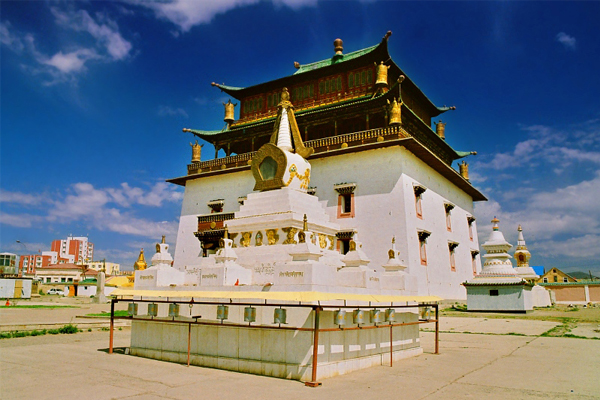

Originally situated in the center of Ulaanbaatar, Gandan Monastery was moved to its present location by the 5th Bogd Jebzundamba in 1838. Over the next century the Monastery grew to include nine datsans or institutes, a library and housed a community of around 5000 monks. Gandan became an important center for learning and practicing Buddha's teachings, not only in Mongolia but for the entire Mahayana Buddhist community. Small mobile monasteries functioned in Mongolia, and in 1838 the Gandantegchinlen monastery was founded as the religious center of Sutra-Tantra Buddhism at the site of Dalkha hill. It grew into a complex of colleges including a college of basic Buddhist teachings, departments of Astrology and Medicine, and as such was the largest center of the Mongolian Buddhism. The first temple of the Monastery was built at the initiative of the Mongolian living Buddha, the Fifth Incarnation Bogdo, Chultem-Jigmid-Dambijantsan. It was constructed by Mongolian masters and made mostly of wood and earth following Mongolian national architectural designs, with gold plated roofes and topmost Buddhist symbolic - decorations. Many of the Boddhisattvas statues and images established in Gandan temple are of significance. In the temple there are a bronze statue of the Lofty Noble Rimpoche Zanabazar - the Mongolian living Buddha of the First Incarnation sculpted by himself at the behest of his mother; the collection of the Buddha's fundamental teachings, the Tripitaka (Gangiur) in 108 volumes; the silver statue of the famous Tsong (Khapa) of Amdo made in XVI century in Western Oirat Mongolia.
In 1938, the communists suppressed religious communities in Mongolia. They destroyed around 700 monasteries, though a handful were turned into museums. The monks were killed, jailed, or forced to join the army or laity. Five temples of Gandan Monastery were destroyed. The remaining temples were used to accommodate Russian officials or used as barns to keep their horses. In 1944 after a petition from several monks, Gandan Monastery was reopened but its functions were carried out under the strict supervision of the socialist government. In 1990, after the Democratic Revolution and with Buddhism flourishing once more, Gandan Monastery embarked on an ambitious restoration program around the country. There are currently 10 datsans and temples operating at Gandan Monastery, and approximately 900 monks.
The Migjid Janraisig Temple is an important part of Gandan Monastery. The temple houses the majestic new gilded statue of Migjid Janraisig, decorated with jewels. This 26 meter high 20 ton statue is a copy of another statue that was destroyed in the 1920's by communists. The statue was built with donations of Mongolian people as symbol of Buddhist revival in the mid 1990's.
Recommended


Mongolian winter is the most incredible winter that one might experience and there is plenty to see and enjoy during a winter travel. Glittering white snow, clear fresh air, sun, and little chills are the image of Mongolian winter. Taking this fan...
Duration: 3 Days / 2 Nights
Destination: Gobi - Central


All of Mongolians celebrate the Lunar New Year, which is called in Mongolia “Tsagaan Sar” or the “White Moon”. It is widely celebrated throughout the country around January or February according to the combination of Solar-...





